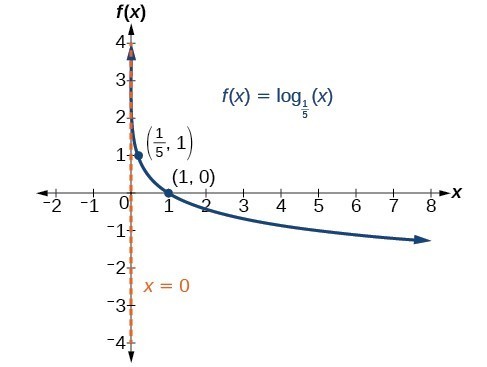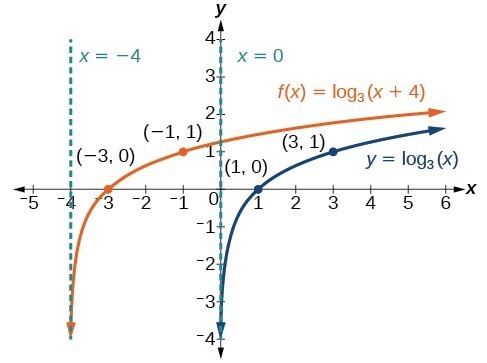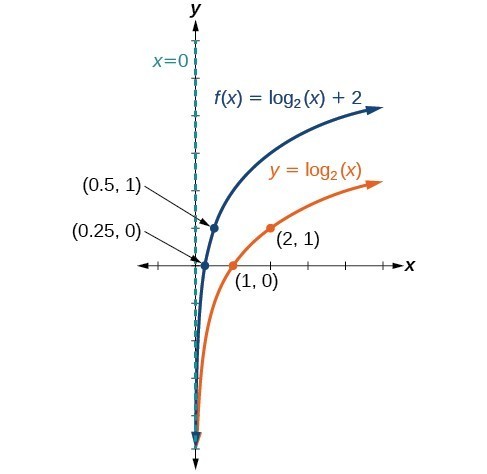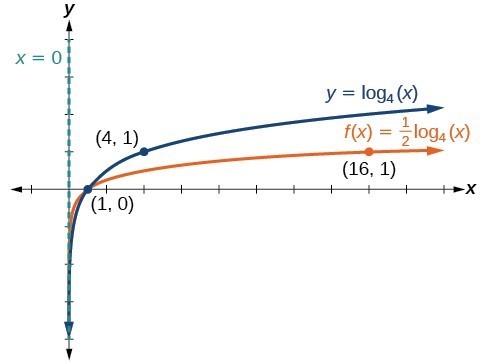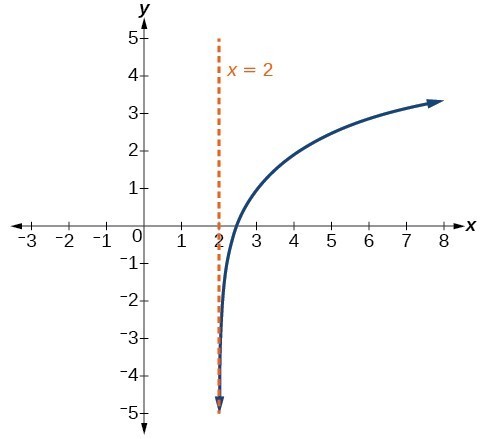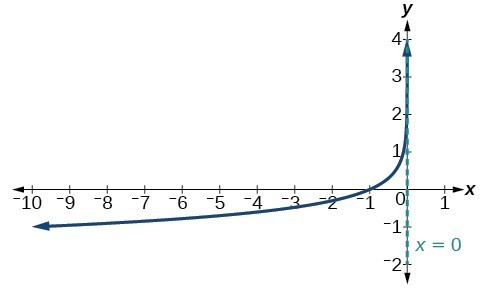Learning Outcomes
- Convert between logarithmic to exponential form.
- Evaluate logarithms.
- Use common logarithms to model real-world problems.
- Use natural logarithms to model real-world problems.
- Identify the domain of a logarithmic function.
- Graph logarithmic functions.
- Use the product rule for logarithms.
- Use the quotient rule for logarithms.
- Use the power rule for logarithms.
- Expand logarithmic expressions.
- Condense logarithmic expressions.
- Use the change-of-base formula for logarithms.

Figure 1. Devastation of March 11, 2011 earthquake in Honshu, Japan. (credit: Daniel Pierce)
In 2010, a major earthquake struck Haiti, destroying or damaging over 285,000 homes.[1] One year later, another, stronger earthquake devastated Honshu, Japan, destroying or damaging over 332,000 buildings,[2] like those shown in the picture above. Even though both caused substantial damage, the earthquake in 2011 was 100 times stronger than the earthquake in Haiti. How do we know? The magnitudes of earthquakes are measured on a scale known as the Richter Scale. The Haitian earthquake registered a 7.0 on the Richter Scale[3] whereas the Japanese earthquake registered a 9.0.[4]
The Richter Scale is a base-ten logarithmic scale. In other words, an earthquake of magnitude 8 is not twice as great as an earthquake of magnitude 4. It is [latex]{10}^{8 - 4}={10}^{4}=10,000[/latex] times as great! In this lesson, we will investigate the nature of the Richter Scale and the base-ten function upon which it depends.
Convert from logarithmic to exponential form
In order to analyze the magnitude of earthquakes or compare the magnitudes of two different earthquakes, we need to be able to convert between logarithmic and exponential form. For example, suppose the amount of energy released from one earthquake were 500 times greater than the amount of energy released from another. We want to calculate the difference in magnitude. The equation that represents this problem is [latex]{10}^{x}=500[/latex], where x represents the difference in magnitudes on the Richter Scale. How would we solve for x?
We have not yet learned a method for solving exponential equations. None of the algebraic tools discussed so far is sufficient to solve [latex]{10}^{x}=500[/latex]. We know that [latex]{10}^{2}=100[/latex] and [latex]{10}^{3}=1000[/latex], so it is clear that x must be some value between 2 and 3, since [latex]y={10}^{x}[/latex] is increasing. We can examine a graph to better estimate the solution.
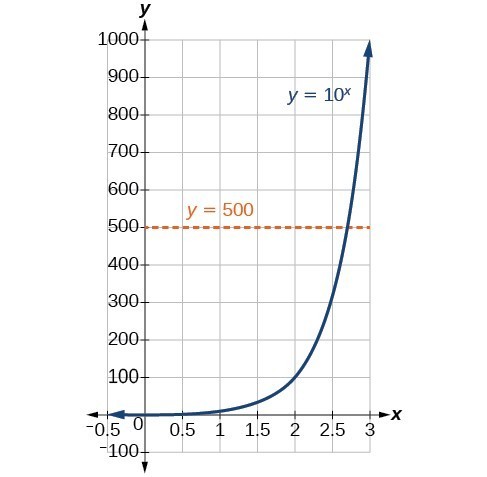
Figure 2
Estimating from a graph, however, is imprecise. To find an algebraic solution, we must introduce a new function. Observe that the graph above passes the horizontal line test. The exponential function [latex]y={b}^{x}[/latex] is one-to-one, so its inverse, [latex]x={b}^{y}[/latex] is also a function. As is the case with all inverse functions, we simply interchange x and y and solve for y to find the inverse function. To represent y as a function of x, we use a logarithmic function of the form [latex]y={\mathrm{log}}_{b}\left(x\right)[/latex]. The base b logarithm of a number is the exponent by which we must raise b to get that number.
We read a logarithmic expression as, “The logarithm with base b of x is equal to y,” or, simplified, “log base b of x is y.” We can also say, “b raised to the power of y is x,” because logs are exponents. For example, the base 2 logarithm of 32 is 5, because 5 is the exponent we must apply to 2 to get 32. Since [latex]{2}^{5}=32[/latex], we can write [latex]{\mathrm{log}}_{2}32=5[/latex]. We read this as “log base 2 of 32 is 5.”
We can express the relationship between logarithmic form and its corresponding exponential form as follows:
Note that the base b is always positive.

Because logarithm is a function, it is most correctly written as [latex]{\mathrm{log}}_{b}\left(x\right)[/latex], using parentheses to denote function evaluation, just as we would with [latex]f\left(x\right)[/latex]. However, when the input is a single variable or number, it is common to see the parentheses dropped and the expression written without parentheses, as [latex]{\mathrm{log}}_{b}x[/latex]. Note that many calculators require parentheses around the x.
We can illustrate the notation of logarithms as follows:

Notice that, comparing the logarithm function and the exponential function, the input and the output are switched. This means [latex]y={\mathrm{log}}_{b}\left(x\right)[/latex] and [latex]y={b}^{x}[/latex] are inverse functions.
A General Note: Definition of the Logarithmic Function
A logarithm base b of a positive number x satisfies the following definition.
For [latex]x>0,b>0,b\ne 1[/latex],
where,
- we read [latex]{\mathrm{log}}_{b}\left(x\right)[/latex] as, “the logarithm with base b of x” or the “log base b of x.”
- the logarithm y is the exponent to which b must be raised to get x.
Also, since the logarithmic and exponential functions switch the x and y values, the domain and range of the exponential function are interchanged for the logarithmic function. Therefore,
- the domain of the logarithm function with base [latex]b \text{ is} \left(0,\infty \right)[/latex].
- the range of the logarithm function with base [latex]b \text{ is} \left(-\infty ,\infty \right)[/latex].
Q & A
Can we take the logarithm of a negative number?
No. Because the base of an exponential function is always positive, no power of that base can ever be negative. We can never take the logarithm of a negative number. Also, we cannot take the logarithm of zero. Calculators may output a log of a negative number when in complex mode, but the log of a negative number is not a real number.
How To: Given an equation in logarithmic form [latex]{\mathrm{log}}_{b}\left(x\right)=y[/latex], convert it to exponential form.
- Examine the equation [latex]y={\mathrm{log}}_{b}x[/latex] and identify b, y, and x.
- Rewrite [latex]{\mathrm{log}}_{b}x=y[/latex] as [latex]{b}^{y}=x[/latex].
Example 1: Converting from Logarithmic Form to Exponential Form
Write the following logarithmic equations in exponential form.
- [latex]{\mathrm{log}}_{6}\left(\sqrt{6}\right)=\frac{1}{2}[/latex]
- [latex]{\mathrm{log}}_{3}\left(9\right)=2[/latex]
Try It
Write the following logarithmic equations in exponential form.
a. [latex]{\mathrm{log}}_{10}\left(1,000,000\right)=6[/latex]
b. [latex]{\mathrm{log}}_{5}\left(25\right)=2[/latex]
Try It
Convert from exponential to logarithmic form
To convert from exponents to logarithms, we follow the same steps in reverse. We identify the base b, exponent x, and output y. Then we write [latex]x={\mathrm{log}}_{b}\left(y\right)[/latex].
Example 2: Converting from Exponential Form to Logarithmic Form
Write the following exponential equations in logarithmic form.
- [latex]{2}^{3}=8[/latex]
- [latex]{5}^{2}=25[/latex]
- [latex]{10}^{-4}=\frac{1}{10,000}[/latex]
Try It
Write the following exponential equations in logarithmic form.
a. [latex]{3}^{2}=9[/latex]
b. [latex]{5}^{3}=125[/latex]
c. [latex]{2}^{-1}=\frac{1}{2}[/latex]
Try It
Evaluate logarithms
Knowing the squares, cubes, and roots of numbers allows us to evaluate many logarithms mentally. For example, consider [latex]{\mathrm{log}}_{2}8[/latex]. We ask, “To what exponent must 2 be raised in order to get 8?” Because we already know [latex]{2}^{3}=8[/latex], it follows that [latex]{\mathrm{log}}_{2}8=3[/latex].
Now consider solving [latex]{\mathrm{log}}_{7}49[/latex] and [latex]{\mathrm{log}}_{3}27[/latex] mentally.
- We ask, “To what exponent must 7 be raised in order to get 49?” We know [latex]{7}^{2}=49[/latex]. Therefore, [latex]{\mathrm{log}}_{7}49=2[/latex]
- We ask, “To what exponent must 3 be raised in order to get 27?” We know [latex]{3}^{3}=27[/latex]. Therefore, [latex]{\mathrm{log}}_{3}27=3[/latex]
Even some seemingly more complicated logarithms can be evaluated without a calculator. For example, let’s evaluate [latex]{\mathrm{log}}_{\frac{2}{3}}\frac{4}{9}[/latex] mentally.
- We ask, “To what exponent must [latex]\frac{2}{3}[/latex] be raised in order to get [latex]\frac{4}{9}[/latex]? ” We know [latex]{2}^{2}=4[/latex] and [latex]{3}^{2}=9[/latex], so [latex]{\left(\frac{2}{3}\right)}^{2}=\frac{4}{9}[/latex]. Therefore, [latex]{\mathrm{log}}_{\frac{2}{3}}\left(\frac{4}{9}\right)=2[/latex].
How To: Given a logarithm of the form [latex]y={\mathrm{log}}_{b}\left(x\right)[/latex], evaluate it mentally.
- Rewrite the argument x as a power of b: [latex]{b}^{y}=x[/latex].
- Use previous knowledge of powers of b identify y by asking, “To what exponent should b be raised in order to get x?”
Example 3: Solving Logarithms Mentally
Solve [latex]y={\mathrm{log}}_{4}\left(64\right)[/latex] without using a calculator.
Try It
Solve [latex]y={\mathrm{log}}_{121}\left(11\right)[/latex] without using a calculator.
Example 4: Evaluating the Logarithm of a Reciprocal
Evaluate [latex]y={\mathrm{log}}_{3}\left(\frac{1}{27}\right)[/latex] without using a calculator.
Try It
Evaluate [latex]y={\mathrm{log}}_{2}\left(\frac{1}{32}\right)[/latex] without using a calculator.
Try It
Use common logarithms
The most frequently used base for logarithms is e. Base e logarithms are important in calculus and some scientific applications; they are called natural logarithms. The base e logarithm, [latex]{\mathrm{log}}_{e}\left(x\right)[/latex], has its own notation, [latex]\mathrm{ln}\left(x\right)[/latex].
Most values of [latex]\mathrm{ln}\left(x\right)[/latex] can be found only using a calculator. The major exception is that, because the logarithm of 1 is always 0 in any base, [latex]\mathrm{ln}1=0[/latex]. For other natural logarithms, we can use the [latex]\mathrm{ln}[/latex] key that can be found on most scientific calculators. We can also find the natural logarithm of any power of e using the inverse property of logarithms.
A General Note: Definition of the Natural Logarithm
A natural logarithm is a logarithm with base e. We write [latex]{\mathrm{log}}_{e}\left(x\right)[/latex] simply as [latex]\mathrm{ln}\left(x\right)[/latex]. The natural logarithm of a positive number x satisfies the following definition.
For [latex]x>0[/latex],
We read [latex]\mathrm{ln}\left(x\right)[/latex] as, “the logarithm with base e of x” or “the natural logarithm of x.”
The logarithm y is the exponent to which e must be raised to get x.
Since the functions [latex]y=e{}^{x}[/latex] and [latex]y=\mathrm{ln}\left(x\right)[/latex] are inverse functions, [latex]\mathrm{ln}\left({e}^{x}\right)=x[/latex] for all x and [latex]e{}^{\mathrm{ln}\left(x\right)}=x[/latex] for x > 0.
How To: Given a natural logarithm with the form [latex]y=\mathrm{ln}\left(x\right)[/latex], evaluate it using a calculator.
- Press [LN].
- Enter the value given for x, followed by [ ) ].
- Press [ENTER].
Example 5: Evaluating a Natural Logarithm Using a Calculator
Evaluate [latex]y=\mathrm{ln}\left(500\right)[/latex] to four decimal places using a calculator.
Try It
Evaluate [latex]\mathrm{ln}\left(-500\right)[/latex].
Try It
In Graphs of Exponential Functions, we saw how creating a graphical representation of an exponential model gives us another layer of insight for predicting future events. How do logarithmic graphs give us insight into situations? Because every logarithmic function is the inverse function of an exponential function, we can think of every output on a logarithmic graph as the input for the corresponding inverse exponential equation. In other words, logarithms give the cause for an effect.
To illustrate, suppose we invest $2500 in an account that offers an annual interest rate of 5%, compounded continuously. We already know that the balance in our account for any year t can be found with the equation [latex]A=2500{e}^{0.05t}[/latex].
But what if we wanted to know the year for any balance? We would need to create a corresponding new function by interchanging the input and the output; thus we would need to create a logarithmic model for this situation. By graphing the model, we can see the output (year) for any input (account balance). For instance, what if we wanted to know how many years it would take for our initial investment to double? Figure 1 shows this point on the logarithmic graph.
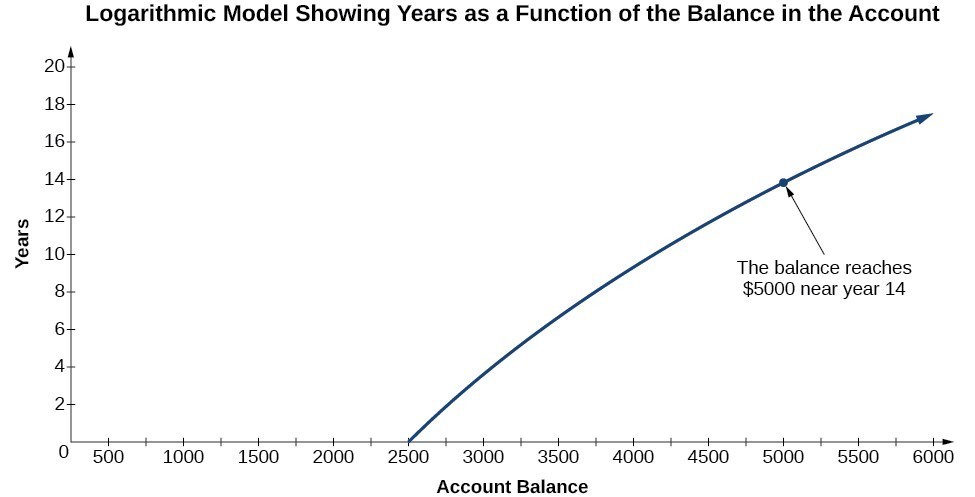
Figure 1
In this section we will discuss the values for which a logarithmic function is defined, and then turn our attention to graphing the family of logarithmic functions.
Identify the domain of a logarithmic function
Before working with graphs, we will take a look at the domain (the set of input values) for which the logarithmic function is defined.
Recall that the exponential function is defined as [latex]y={b}^{x}[/latex] for any real number x and constant [latex]b>0[/latex], [latex]b\ne 1[/latex], where
- The domain of y is [latex]\left(-\infty ,\infty \right)[/latex].
- The range of y is [latex]\left(0,\infty \right)[/latex].
In the last section we learned that the logarithmic function [latex]y={\mathrm{log}}_{b}\left(x\right)[/latex] is the inverse of the exponential function [latex]y={b}^{x}[/latex]. So, as inverse functions:
- The domain of [latex]y={\mathrm{log}}_{b}\left(x\right)[/latex] is the range of [latex]y={b}^{x}[/latex]:[latex]\left(0,\infty \right)[/latex].
- The range of [latex]y={\mathrm{log}}_{b}\left(x\right)[/latex] is the domain of [latex]y={b}^{x}[/latex]: [latex]\left(-\infty ,\infty \right)[/latex].
Transformations of the parent function [latex]y={\mathrm{log}}_{b}\left(x\right)[/latex] behave similarly to those of other functions. Just as with other parent functions, we can apply the four types of transformations—shifts, stretches, compressions, and reflections—to the parent function without loss of shape.
In Graphs of Exponential Functions we saw that certain transformations can change the range of [latex]y={b}^{x}[/latex]. Similarly, applying transformations to the parent function [latex]y={\mathrm{log}}_{b}\left(x\right)[/latex] can change the domain. When finding the domain of a logarithmic function, therefore, it is important to remember that the domain consists only of positive real numbers. That is, the argument of the logarithmic function must be greater than zero.
For example, consider [latex]f\left(x\right)={\mathrm{log}}_{4}\left(2x - 3\right)[/latex]. This function is defined for any values of x such that the argument, in this case [latex]2x - 3[/latex], is greater than zero. To find the domain, we set up an inequality and solve for x:
In interval notation, the domain of [latex]f\left(x\right)={\mathrm{log}}_{4}\left(2x - 3\right)[/latex] is [latex]\left(1.5,\infty \right)[/latex].
How To: Given a logarithmic function, identify the domain.
- Set up an inequality showing the argument greater than zero.
- Solve for x.
- Write the domain in interval notation.
Example 1: Identifying the Domain of a Logarithmic Shift
What is the domain of [latex]f\left(x\right)={\mathrm{log}}_{2}\left(x+3\right)[/latex]?
Try It
What is the domain of [latex]f\left(x\right)={\mathrm{log}}_{5}\left(x - 2\right)+1[/latex]?
Example 2: Identifying the Domain of a Logarithmic Shift and Reflection
What is the domain of [latex]f\left(x\right)=\mathrm{log}\left(5 - 2x\right)[/latex]?
Try It
What is the domain of [latex]f\left(x\right)=\mathrm{log}\left(x - 5\right)+2[/latex]?
Try It
Graph logarithmic functions
Now that we have a feel for the set of values for which a logarithmic function is defined, we move on to graphing logarithmic functions. The family of logarithmic functions includes the parent function [latex]y={\mathrm{log}}_{b}\left(x\right)[/latex] along with all its transformations: shifts, stretches, compressions, and reflections.
We begin with the parent function [latex]y={\mathrm{log}}_{b}\left(x\right)[/latex]. Because every logarithmic function of this form is the inverse of an exponential function with the form [latex]y={b}^{x}[/latex], their graphs will be reflections of each other across the line [latex]y=x[/latex]. To illustrate this, we can observe the relationship between the input and output values of [latex]y={2}^{x}[/latex] and its equivalent [latex]x={\mathrm{log}}_{2}\left(y\right)[/latex] in the table below.
| x | –3 | –2 | –1 | 0 | 1 | 2 | 3 |
| [latex]{2}^{x}=y[/latex] | [latex]\frac{1}{8}[/latex] | [latex]\frac{1}{4}[/latex] | [latex]\frac{1}{2}[/latex] | 1 | 2 | 4 | 8 |
| [latex]{\mathrm{log}}_{2}\left(y\right)=x[/latex] | –3 | –2 | –1 | 0 | 1 | 2 | 3 |
Using the inputs and outputs from the table above, we can build another table to observe the relationship between points on the graphs of the inverse functions [latex]f\left(x\right)={2}^{x}[/latex] and [latex]g\left(x\right)={\mathrm{log}}_{2}\left(x\right)[/latex].
| [latex]f\left(x\right)={2}^{x}[/latex] | [latex]\left(-3,\frac{1}{8}\right)[/latex] | [latex]\left(-2,\frac{1}{4}\right)[/latex] | [latex]\left(-1,\frac{1}{2}\right)[/latex] | [latex]\left(0,1\right)[/latex] | [latex]\left(1,2\right)[/latex] | [latex]\left(2,4\right)[/latex] | [latex]\left(3,8\right)[/latex] |
| [latex]g\left(x\right)={\mathrm{log}}_{2}\left(x\right)[/latex] | [latex]\left(\frac{1}{8},-3\right)[/latex] | [latex]\left(\frac{1}{4},-2\right)[/latex] | [latex]\left(\frac{1}{2},-1\right)[/latex] | [latex]\left(1,0\right)[/latex] | [latex]\left(2,1\right)[/latex] | [latex]\left(4,2\right)[/latex] | [latex]\left(8,3\right)[/latex] |
As we’d expect, the x– and y-coordinates are reversed for the inverse functions. The figure below shows the graph of f and g.
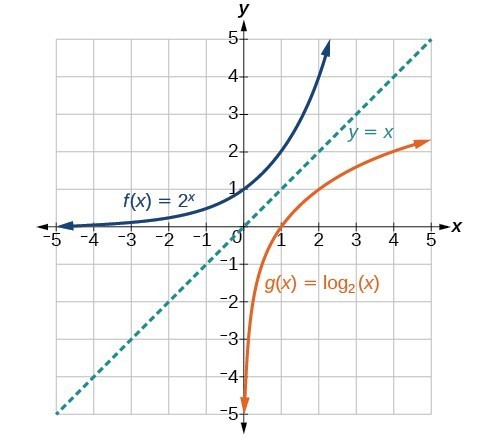
Figure 2. Notice that the graphs of [latex]f\left(x\right)={2}^{x}[/latex] and [latex]g\left(x\right)={\mathrm{log}}_{2}\left(x\right)[/latex] are reflections about the line y = x.
Observe the following from the graph:
- [latex]f\left(x\right)={2}^{x}[/latex] has a y-intercept at [latex]\left(0,1\right)[/latex] and [latex]g\left(x\right)={\mathrm{log}}_{2}\left(x\right)[/latex] has an x-intercept at [latex]\left(1,0\right)[/latex].
- The domain of [latex]f\left(x\right)={2}^{x}[/latex], [latex]\left(-\infty ,\infty \right)[/latex], is the same as the range of [latex]g\left(x\right)={\mathrm{log}}_{2}\left(x\right)[/latex].
- The range of [latex]f\left(x\right)={2}^{x}[/latex], [latex]\left(0,\infty \right)[/latex], is the same as the domain of [latex]g\left(x\right)={\mathrm{log}}_{2}\left(x\right)[/latex].
A General Note: Characteristics of the Graph of the Parent Function, f(x) = logb(x)
For any real number x and constant b > 0, [latex]b\ne 1[/latex], we can see the following characteristics in the graph of [latex]f\left(x\right)={\mathrm{log}}_{b}\left(x\right)[/latex]:
- one-to-one function
- vertical asymptote: x = 0
- domain: [latex]\left(0,\infty \right)[/latex]
- range: [latex]\left(-\infty ,\infty \right)[/latex]
- x-intercept: [latex]\left(1,0\right)[/latex] and key point [latex]\left(b,1\right)[/latex]
- y-intercept: none
- increasing if [latex]b>1[/latex]
- decreasing if 0 < b < 1
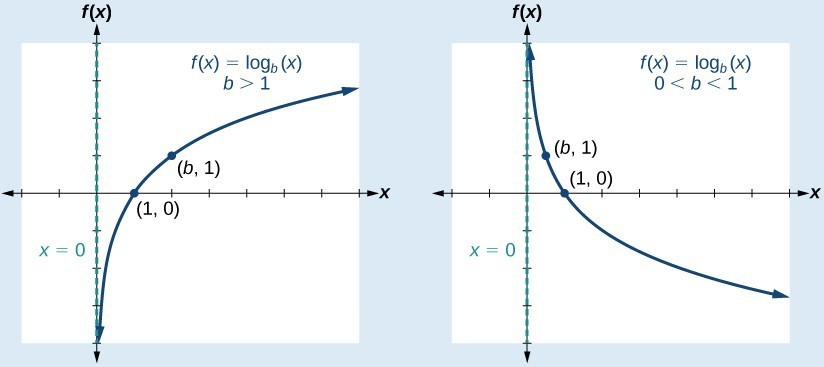
Figure 3 shows how changing the base b in [latex]f\left(x\right)={\mathrm{log}}_{b}\left(x\right)[/latex] can affect the graphs. Observe that the graphs compress vertically as the value of the base increases. (Note: recall that the function [latex]\mathrm{ln}\left(x\right)[/latex] has base [latex]e\approx \text{2}.\text{718.)}[/latex]
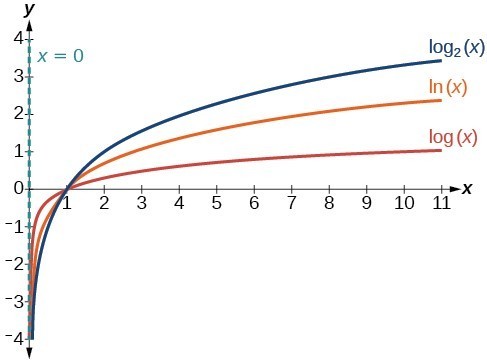
Figure 4. The graphs of three logarithmic functions with different bases, all greater than 1.
How To: Given a logarithmic function with the form [latex]f\left(x\right)={\mathrm{log}}_{b}\left(x\right)[/latex], graph the function.
- Draw and label the vertical asymptote, x = 0.
- Plot the x-intercept, [latex]\left(1,0\right)[/latex].
- Plot the key point [latex]\left(b,1\right)[/latex].
- Draw a smooth curve through the points.
- State the domain, [latex]\left(0,\infty \right)[/latex], the range, [latex]\left(-\infty ,\infty \right)[/latex], and the vertical asymptote, x = 0.
Example 3: Graphing a Logarithmic Function with the Form [latex]f\left(x\right)={\mathrm{log}}_{b}\left(x\right)[/latex].
Graph [latex]f\left(x\right)={\mathrm{log}}_{5}\left(x\right)[/latex]. State the domain, range, and asymptote.
Try It
Graph [latex]f\left(x\right)={\mathrm{log}}_{\frac{1}{5}}\left(x\right)[/latex]. State the domain, range, and asymptote.
Try It
Graphing Transformations of Logarithmic Functions
As we mentioned in the beginning of the section, transformations of logarithmic graphs behave similarly to those of other parent functions. We can shift, stretch, compress, and reflect the parent function [latex]y={\mathrm{log}}_{b}\left(x\right)[/latex] without loss of shape.
Graphing a Horizontal Shift of [latex]f\left(x\right)={\mathrm{log}}_{b}\left(x\right)[/latex]
When a constant c is added to the input of the parent function [latex]f\left(x\right)=\text{log}_{b}\left(x\right)[/latex], the result is a horizontal shift c units in the opposite direction of the sign on c. To visualize horizontal shifts, we can observe the general graph of the parent function [latex]f\left(x\right)={\mathrm{log}}_{b}\left(x\right)[/latex] and for c > 0 alongside the shift left, [latex]g\left(x\right)={\mathrm{log}}_{b}\left(x+c\right)[/latex], and the shift right, [latex]h\left(x\right)={\mathrm{log}}_{b}\left(x-c\right)[/latex].
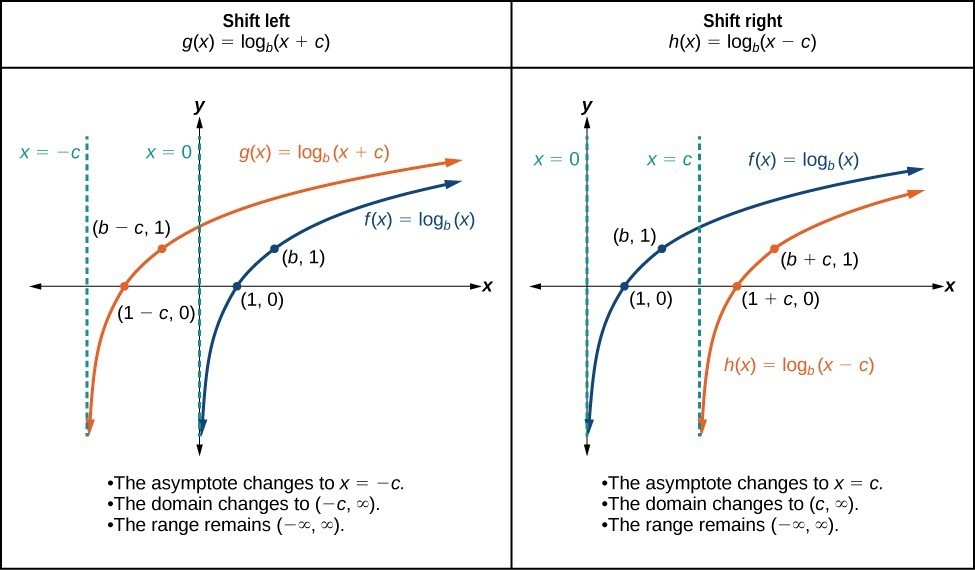
Figure 6
A General Note: Horizontal Shifts of the Parent Function [latex]y=\text{log}_{b}\left(x\right)[/latex]
For any constant c, the function [latex]f\left(x\right)={\mathrm{log}}_{b}\left(x+c\right)[/latex]
- shifts the parent function [latex]y={\mathrm{log}}_{b}\left(x\right)[/latex] left c units if c > 0.
- shifts the parent function [latex]y={\mathrm{log}}_{b}\left(x\right)[/latex] right c units if c < 0.
- has the vertical asymptote x = –c.
- has domain [latex]\left(-c,\infty \right)[/latex].
- has range [latex]\left(-\infty ,\infty \right)[/latex].
How To: Given a logarithmic function with the form [latex]f\left(x\right)={\mathrm{log}}_{b}\left(x+c\right)[/latex], graph the translation.
- Identify the horizontal shift:
- If c > 0, shift the graph of [latex]f\left(x\right)={\mathrm{log}}_{b}\left(x\right)[/latex] left c units.
- If c < 0, shift the graph of [latex]f\left(x\right)={\mathrm{log}}_{b}\left(x\right)[/latex] right c units.
- Draw the vertical asymptote x = –c.
- Identify three key points from the parent function. Find new coordinates for the shifted functions by subtracting c from the x coordinate.
- Label the three points.
- The Domain is [latex]\left(-c,\infty \right)[/latex], the range is [latex]\left(-\infty ,\infty \right)[/latex], and the vertical asymptote is x = –c.
Example 4: Graphing a Horizontal Shift of the Parent Function [latex]y=\text{log}_{b}\left(x\right)[/latex]
Sketch the horizontal shift [latex]f\left(x\right)={\mathrm{log}}_{3}\left(x - 2\right)[/latex] alongside its parent function. Include the key points and asymptotes on the graph. State the domain, range, and asymptote.
Try It
Sketch a graph of [latex]f\left(x\right)={\mathrm{log}}_{3}\left(x+4\right)[/latex] alongside its parent function. Include the key points and asymptotes on the graph. State the domain, range, and asymptote.
Try It
Graphing a Vertical Shift of [latex]y=\text{log}_{b}\left(x\right)[/latex]
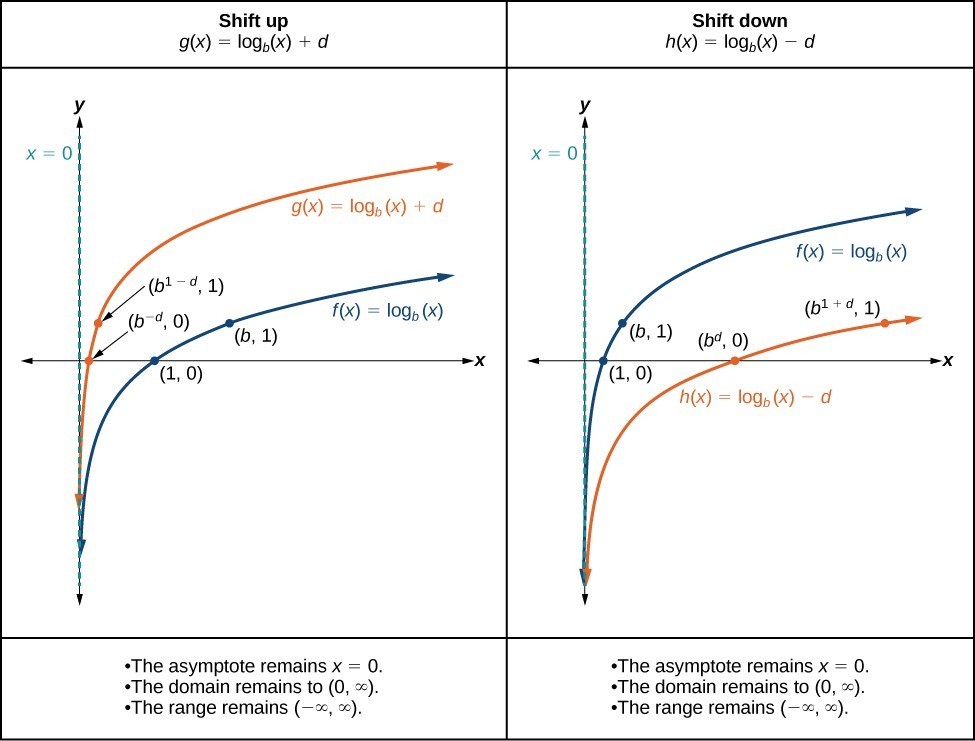
Figure 8
A General Note: Vertical Shifts of the Parent Function [latex]y=\text{log}_{b}\left(x\right)[/latex]
For any constant d, the function [latex]f\left(x\right)={\mathrm{log}}_{b}\left(x\right)+d[/latex]
- shifts the parent function [latex]y={\mathrm{log}}_{b}\left(x\right)[/latex] up d units if d > 0.
- shifts the parent function [latex]y={\mathrm{log}}_{b}\left(x\right)[/latex] down d units if d < 0.
- has the vertical asymptote x = 0.
- has domain [latex]\left(0,\infty \right)[/latex].
- has range [latex]\left(-\infty ,\infty \right)[/latex].
How To: Given a logarithmic function with the form [latex]f\left(x\right)={\mathrm{log}}_{b}\left(x\right)+d[/latex], graph the translation.
- Identify the vertical shift:
- If d > 0, shift the graph of [latex]f\left(x\right)={\mathrm{log}}_{b}\left(x\right)[/latex] up d units.
- If d < 0, shift the graph of [latex]f\left(x\right)={\mathrm{log}}_{b}\left(x\right)[/latex] down d units.
- Draw the vertical asymptote x = 0.
- Identify three key points from the parent function. Find new coordinates for the shifted functions by adding d to the y coordinate.
- Label the three points.
- The domain is [latex]\left(0,\infty \right)[/latex], the range is [latex]\left(-\infty ,\infty \right)[/latex], and the vertical asymptote is x = 0.
Example 5: Graphing a Vertical Shift of the Parent Function [latex]y=\text{log}_{b}\left(x\right)[/latex]
Sketch a graph of [latex]f\left(x\right)={\mathrm{log}}_{3}\left(x\right)-2[/latex] alongside its parent function. Include the key points and asymptote on the graph. State the domain, range, and asymptote.
Try It
Sketch a graph of [latex]f\left(x\right)={\mathrm{log}}_{2}\left(x\right)+2[/latex] alongside its parent function. Include the key points and asymptote on the graph. State the domain, range, and asymptote.
Try It
Graphing Stretches and Compressions of [latex]y=\text{log}_{b}\left(x\right)[/latex]
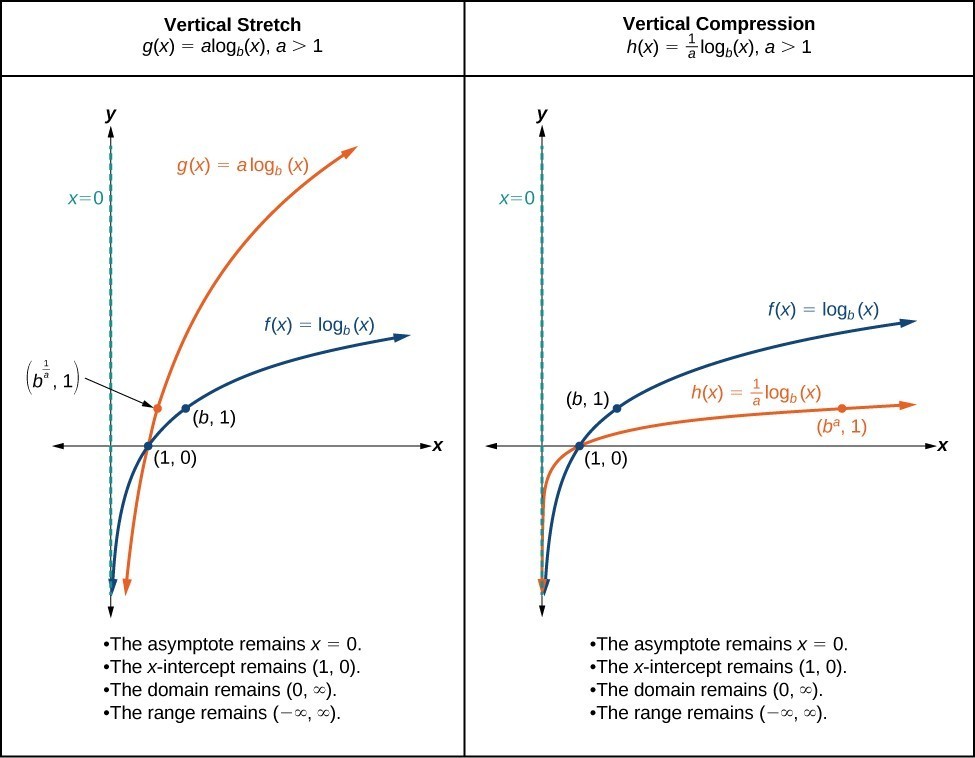
A General Note: Vertical Stretches and Compressions of the Parent Function [latex]y=\text{log}_{b}\left(x\right)[/latex]
For any constant a > 1, the function [latex]f\left(x\right)=a{\mathrm{log}}_{b}\left(x\right)[/latex]
- stretches the parent function [latex]y={\mathrm{log}}_{b}\left(x\right)[/latex] vertically by a factor of a if a > 1.
- compresses the parent function [latex]y={\mathrm{log}}_{b}\left(x\right)[/latex] vertically by a factor of a if 0 < a < 1.
- has the vertical asymptote x = 0.
- has the x-intercept [latex]\left(1,0\right)[/latex].
- has domain [latex]\left(0,\infty \right)[/latex].
- has range [latex]\left(-\infty ,\infty \right)[/latex].
How To: Given a logarithmic function with the form [latex]f\left(x\right)=a{\mathrm{log}}_{b}\left(x\right)[/latex], [latex]a>0[/latex], graph the translation.
- Identify the vertical stretch or compressions:
- If [latex]|a|>1[/latex], the graph of [latex]f\left(x\right)={\mathrm{log}}_{b}\left(x\right)[/latex] is stretched by a factor of a units.
- If [latex]|a|<1[/latex], the graph of [latex]f\left(x\right)={\mathrm{log}}_{b}\left(x\right)[/latex] is compressed by a factor of a units.
- Draw the vertical asymptote x = 0.
- Identify three key points from the parent function. Find new coordinates for the shifted functions by multiplying the y coordinates by a.
- Label the three points.
- The domain is [latex]\left(0,\infty \right)[/latex], the range is [latex]\left(-\infty ,\infty \right)[/latex], and the vertical asymptote is x = 0.
Example 6: Graphing a Stretch or Compression of the Parent Function [latex]y=\text{log}_{b}\left(x\right)[/latex]
Sketch a graph of [latex]f\left(x\right)=2{\mathrm{log}}_{4}\left(x\right)[/latex] alongside its parent function. Include the key points and asymptote on the graph. State the domain, range, and asymptote.
Try It
Sketch a graph of [latex]f\left(x\right)=\frac{1}{2}{\mathrm{log}}_{4}\left(x\right)[/latex] alongside its parent function. Include the key points and asymptote on the graph. State the domain, range, and asymptote.
Example 7: Combining a Shift and a Stretch
Sketch a graph of [latex]f\left(x\right)=5\mathrm{log}\left(x+2\right)[/latex]. State the domain, range, and asymptote.
Try It
Sketch a graph of the function [latex]f\left(x\right)=3\mathrm{log}\left(x - 2\right)+1[/latex]. State the domain, range, and asymptote.
Try It
Graphing Reflections of [latex]f\left(x\right)={\mathrm{log}}_{b}\left(x\right)[/latex]
When the parent function [latex]f\left(x\right)={\mathrm{log}}_{b}\left(x\right)[/latex] is multiplied by –1, the result is a reflection about the x-axis. When the input is multiplied by –1, the result is a reflection about the y-axis. To visualize reflections, we restrict b > 1, and observe the general graph of the parent function [latex]f\left(x\right)={\mathrm{log}}_{b}\left(x\right)[/latex] alongside the reflection about the x-axis, [latex]g\left(x\right)={\mathrm{-log}}_{b}\left(x\right)[/latex] and the reflection about the y-axis, [latex]h\left(x\right)={\mathrm{log}}_{b}\left(-x\right)[/latex].
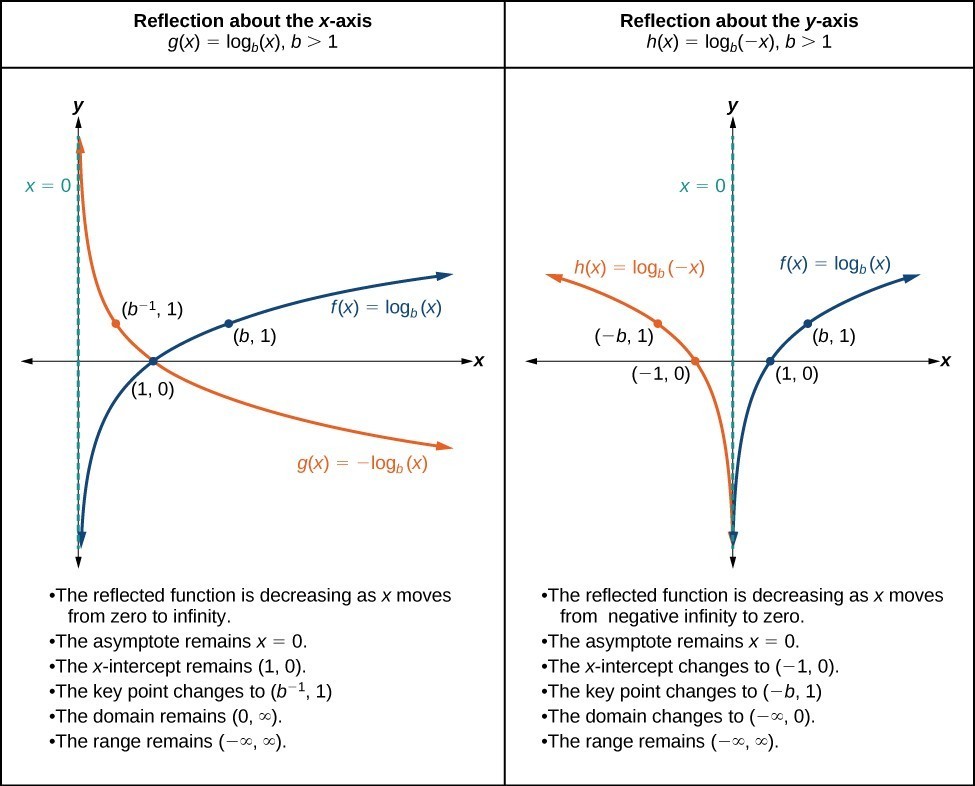
A General Note: Reflections of the Parent Function [latex]y=\text{log}_{b}\left(x\right)[/latex]
The function [latex]f\left(x\right)={\mathrm{-log}}_{b}\left(x\right)[/latex]
- reflects the parent function [latex]y={\mathrm{log}}_{b}\left(x\right)[/latex] about the x-axis.
- has domain, [latex]\left(0,\infty \right)[/latex], range, [latex]\left(-\infty ,\infty \right)[/latex], and vertical asymptote, x = 0, which are unchanged from the parent function.
The function [latex]f\left(x\right)={\mathrm{log}}_{b}\left(-x\right)[/latex]
- reflects the parent function [latex]y={\mathrm{log}}_{b}\left(x\right)[/latex] about the y-axis.
- has domain [latex]\left(-\infty ,0\right)[/latex].
- has range, [latex]\left(-\infty ,\infty \right)[/latex], and vertical asymptote, x = 0, which are unchanged from the parent function.
How To: Given a logarithmic function with the parent function [latex]f\left(x\right)={\mathrm{log}}_{b}\left(x\right)[/latex], graph a translation.
| [latex]\text{If }f\left(x\right)=-{\mathrm{log}}_{b}\left(x\right)[/latex] | [latex]\text{If }f\left(x\right)={\mathrm{log}}_{b}\left(-x\right)[/latex] |
|---|---|
| 1. Draw the vertical asymptote, x = 0. | 1. Draw the vertical asymptote, x = 0. |
| 2. Plot the x-intercept, [latex]\left(1,0\right)[/latex]. | 2. Plot the x-intercept, [latex]\left(1,0\right)[/latex]. |
| 3. Reflect the graph of the parent function [latex]f\left(x\right)={\mathrm{log}}_{b}\left(x\right)[/latex] about the x-axis. | 3. Reflect the graph of the parent function [latex]f\left(x\right)={\mathrm{log}}_{b}\left(x\right)[/latex] about the y-axis. |
| 4. Draw a smooth curve through the points. | 4. Draw a smooth curve through the points. |
| 5. State the domain, [latex]\left(0,\infty \right)[/latex], the range, [latex]\left(-\infty ,\infty \right)[/latex], and the vertical asymptote x = 0. | 5. State the domain, [latex]\left(-\infty ,0\right)[/latex], the range, [latex]\left(-\infty ,\infty \right)[/latex], and the vertical asymptote x = 0. |
Example 8: Graphing a Reflection of a Logarithmic Function
Sketch a graph of [latex]f\left(x\right)=\mathrm{log}\left(-x\right)[/latex] alongside its parent function. Include the key points and asymptote on the graph. State the domain, range, and asymptote.
Try It
Graph [latex]f\left(x\right)=-\mathrm{log}\left(-x\right)[/latex]. State the domain, range, and asymptote.
How To: Given a logarithmic equation, use a graphing calculator to approximate solutions.
- Press [Y=]. Enter the given logarithm equation or equations as Y1= and, if needed, Y2=.
- Press [GRAPH] to observe the graphs of the curves and use [WINDOW] to find an appropriate view of the graphs, including their point(s) of intersection.
- To find the value of x, we compute the point of intersection. Press [2ND] then [CALC]. Select “intersect” and press [ENTER] three times. The point of intersection gives the value of x, for the point(s) of intersection.
Example 9: Approximating the Solution of a Logarithmic Equation
Solve [latex]4\mathrm{ln}\left(x\right)+1=-2\mathrm{ln}\left(x - 1\right)[/latex] graphically. Round to the nearest thousandth.
Try It
Solve [latex]5\mathrm{log}\left(x+2\right)=4-\mathrm{log}\left(x\right)[/latex] graphically. Round to the nearest thousandth.
Summarizing Translations of the Logarithmic Function
Now that we have worked with each type of translation for the logarithmic function, we can summarize each in the table below to arrive at the general equation for translating exponential functions.
| Translations of the Parent Function [latex]y={\mathrm{log}}_{b}\left(x\right)[/latex] | |
|---|---|
| Translation | Form |
Shift
|
[latex]y={\mathrm{log}}_{b}\left(x+c\right)+d[/latex] |
Stretch and Compress
|
[latex]y=a{\mathrm{log}}_{b}\left(x\right)[/latex] |
| Reflect about the x-axis | [latex]y=-{\mathrm{log}}_{b}\left(x\right)[/latex] |
| Reflect about the y-axis | [latex]y={\mathrm{log}}_{b}\left(-x\right)[/latex] |
| General equation for all translations | [latex]y=a{\mathrm{log}}_{b}\left(x+c\right)+d[/latex] |
A General Note: Translations of Logarithmic Functions
All translations of the parent logarithmic function, [latex]y={\mathrm{log}}_{b}\left(x\right)[/latex], have the form
where the parent function, [latex]y={\mathrm{log}}_{b}\left(x\right),b>1[/latex], is
- shifted vertically up d units.
- shifted horizontally to the left c units.
- stretched vertically by a factor of |a| if |a| > 0.
- compressed vertically by a factor of |a| if 0 < |a| < 1.
- reflected about the x-axis when a < 0.
For [latex]f\left(x\right)=\mathrm{log}\left(-x\right)[/latex], the graph of the parent function is reflected about the y-axis.
Example 10: Finding the Vertical Asymptote of a Logarithm Graph
What is the vertical asymptote of [latex]f\left(x\right)=-2{\mathrm{log}}_{3}\left(x+4\right)+5[/latex]?
Try It
What is the vertical asymptote of [latex]f\left(x\right)=3+\mathrm{ln}\left(x - 1\right)[/latex]?
Example 11: Finding the Equation from a Graph
Find a possible equation for the common logarithmic function graphed in Figure 15.
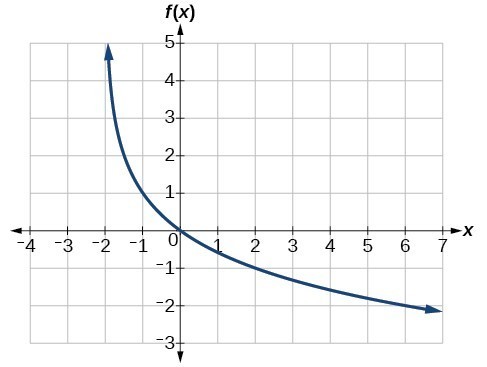
Figure 15
Try It
Give the equation of the natural logarithm graphed in Figure 16.
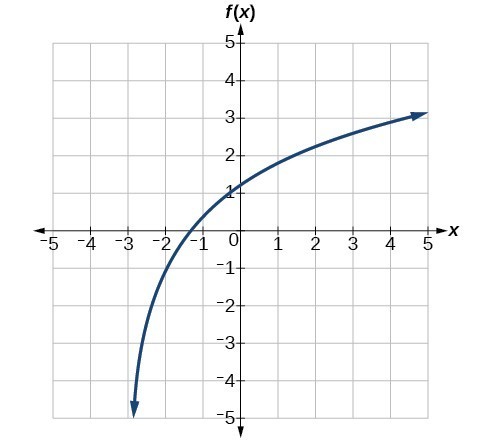
Figure 16
Q & A
Is it possible to tell the domain and range and describe the end behavior of a function just by looking at the graph?
Yes, if we know the function is a general logarithmic function. For example, look at the graph in Try It 11. The graph approaches x = –3 (or thereabouts) more and more closely, so x = –3 is, or is very close to, the vertical asymptote. It approaches from the right, so the domain is all points to the right, [latex]\left\{x|x>-3\right\}[/latex]. The range, as with all general logarithmic functions, is all real numbers. And we can see the end behavior because the graph goes down as it goes left and up as it goes right. The end behavior is that as [latex]x\to -{3}^{+},f\left(x\right)\to -\infty[/latex] and as [latex]x\to \infty ,f\left(x\right)\to \infty[/latex].

Figure 1. The pH of hydrochloric acid is tested with litmus paper. (credit: David Berardan)
In chemistry, pH is used as a measure of the acidity or alkalinity of a substance. The pH scale runs from 0 to 14. Substances with a pH less than 7 are considered acidic, and substances with a pH greater than 7 are said to be alkaline. Our bodies, for instance, must maintain a pH close to 7.35 in order for enzymes to work properly. To get a feel for what is acidic and what is alkaline, consider the following pH levels of some common substances:
- Battery acid: 0.8
- Stomach acid: 2.7
- Orange juice: 3.3
- Pure water: 7 (at 25° C)
- Human blood: 7.35
- Fresh coconut: 7.8
- Sodium hydroxide (lye): 14
To determine whether a solution is acidic or alkaline, we find its pH, which is a measure of the number of active positive hydrogen ions in the solution. The pH is defined by the following formula, where a is the concentration of hydrogen ion in the solution
The equivalence of [latex]-\mathrm{log}\left(\left[{H}^{+}\right]\right)[/latex] and [latex]\mathrm{log}\left(\frac{1}{\left[{H}^{+}\right]}\right)[/latex] is one of the logarithm properties we will examine in this section.
Use the product rule for logarithms
Recall that the logarithmic and exponential functions “undo” each other. This means that logarithms have similar properties to exponents. Some important properties of logarithms are given here. First, the following properties are easy to prove.
For example, [latex]{\mathrm{log}}_{5}1=0[/latex] since [latex]{5}^{0}=1[/latex]. And [latex]{\mathrm{log}}_{5}5=1[/latex] since [latex]{5}^{1}=5[/latex].
Next, we have the inverse property.
For example, to evaluate [latex]\mathrm{log}\left(100\right)[/latex], we can rewrite the logarithm as [latex]{\mathrm{log}}_{10}\left({10}^{2}\right)[/latex], and then apply the inverse property [latex]{\mathrm{log}}_{b}\left({b}^{x}\right)=x[/latex] to get [latex]{\mathrm{log}}_{10}\left({10}^{2}\right)=2[/latex].
To evaluate [latex]{e}^{\mathrm{ln}\left(7\right)}[/latex], we can rewrite the logarithm as [latex]{e}^{{\mathrm{log}}_{e}7}[/latex], and then apply the inverse property [latex]{b}^{{\mathrm{log}}_{b}x}=x[/latex] to get [latex]{e}^{{\mathrm{log}}_{e}7}=7[/latex].
Finally, we have the one-to-one property.
We can use the one-to-one property to solve the equation [latex]{\mathrm{log}}_{3}\left(3x\right)={\mathrm{log}}_{3}\left(2x+5\right)[/latex] for x. Since the bases are the same, we can apply the one-to-one property by setting the arguments equal and solving for x:
But what about the equation [latex]{\mathrm{log}}_{3}\left(3x\right)+{\mathrm{log}}_{3}\left(2x+5\right)=2[/latex]? The one-to-one property does not help us in this instance. Before we can solve an equation like this, we need a method for combining terms on the left side of the equation.
Recall that we use the product rule of exponents to combine the product of exponents by adding: [latex]{x}^{a}{x}^{b}={x}^{a+b}[/latex]. We have a similar property for logarithms, called the product rule for logarithms, which says that the logarithm of a product is equal to a sum of logarithms. Because logs are exponents, and we multiply like bases, we can add the exponents. We will use the inverse property to derive the product rule below.
Given any real number x and positive real numbers M, N, and b, where [latex]b\ne 1[/latex], we will show
Let [latex]m={\mathrm{log}}_{b}M[/latex] and [latex]n={\mathrm{log}}_{b}N[/latex]. In exponential form, these equations are [latex]{b}^{m}=M[/latex] and [latex]{b}^{n}=N[/latex]. It follows that
Note that repeated applications of the product rule for logarithms allow us to simplify the logarithm of the product of any number of factors. For example, consider [latex]{\mathrm{log}}_{b}\left(wxyz\right)[/latex]. Using the product rule for logarithms, we can rewrite this logarithm of a product as the sum of logarithms of its factors:
A General Note: The Product Rule for Logarithms
The product rule for logarithms can be used to simplify a logarithm of a product by rewriting it as a sum of individual logarithms.
[latex]{\mathrm{log}}_{b}\left(MN\right)={\mathrm{log}}_{b}\left(M\right)+{\mathrm{log}}_{b}\left(N\right)\text{ for }b>0[/latex]
How To: Given the logarithm of a product, use the product rule of logarithms to write an equivalent sum of logarithms.
- Factor the argument completely, expressing each whole number factor as a product of primes.
- Write the equivalent expression by summing the logarithms of each factor.
Example 1: Using the Product Rule for Logarithms
Expand [latex]{\mathrm{log}}_{3}\left(30x\left(3x+4\right)\right)[/latex].
Try It
Expand [latex]{\mathrm{log}}_{b}\left(8k\right)[/latex].
Try It
Use the quotient and power rules for logarithms
For quotients, we have a similar rule for logarithms. Recall that we use the quotient rule of exponents to combine the quotient of exponents by subtracting: [latex]{x}^{\frac{a}{b}}={x}^{a-b}[/latex]. The quotient rule for logarithms says that the logarithm of a quotient is equal to a difference of logarithms. Just as with the product rule, we can use the inverse property to derive the quotient rule.
Given any real number x and positive real numbers M, N, and b, where [latex]b\ne 1[/latex], we will show
Let [latex]m={\mathrm{log}}_{b}M[/latex] and [latex]n={\mathrm{log}}_{b}N[/latex]. In exponential form, these equations are [latex]{b}^{m}=M[/latex] and [latex]{b}^{n}=N[/latex]. It follows that
For example, to expand [latex]\mathrm{log}\left(\frac{2{x}^{2}+6x}{3x+9}\right)[/latex], we must first express the quotient in lowest terms. Factoring and canceling we get,
Next we apply the quotient rule by subtracting the logarithm of the denominator from the logarithm of the numerator. Then we apply the product rule.
A General Note: The Quotient Rule for Logarithms
The quotient rule for logarithms can be used to simplify a logarithm or a quotient by rewriting it as the difference of individual logarithms.
How To: Given the logarithm of a quotient, use the quotient rule of logarithms to write an equivalent difference of logarithms.
- Express the argument in lowest terms by factoring the numerator and denominator and canceling common terms.
- Write the equivalent expression by subtracting the logarithm of the denominator from the logarithm of the numerator.
- Check to see that each term is fully expanded. If not, apply the product rule for logarithms to expand completely.
Example 2: Using the Quotient Rule for Logarithms
Expand [latex]{\mathrm{log}}_{2}\left(\frac{15x\left(x - 1\right)}{\left(3x+4\right)\left(2-x\right)}\right)[/latex].
Try It
Expand [latex]{\mathrm{log}}_{3}\left(\frac{7{x}^{2}+21x}{7x\left(x - 1\right)\left(x - 2\right)}\right)[/latex].
Try It
Using the Power Rule for Logarithms
We’ve explored the product rule and the quotient rule, but how can we take the logarithm of a power, such as [latex]{x}^{2}[/latex]? One method is as follows:
Notice that we used the product rule for logarithms to find a solution for the example above. By doing so, we have derived the power rule for logarithms, which says that the log of a power is equal to the exponent times the log of the base. Keep in mind that, although the input to a logarithm may not be written as a power, we may be able to change it to a power. For example,
A General Note: The Power Rule for Logarithms
The power rule for logarithms can be used to simplify the logarithm of a power by rewriting it as the product of the exponent times the logarithm of the base.
[latex]{\mathrm{log}}_{b}\left({M}^{n}\right)=n{\mathrm{log}}_{b}M[/latex]
How To: Given the logarithm of a power, use the power rule of logarithms to write an equivalent product of a factor and a logarithm.
- Express the argument as a power, if needed.
- Write the equivalent expression by multiplying the exponent times the logarithm of the base.
Example 3: Expanding a Logarithm with Powers
Expand [latex]{\mathrm{log}}_{2}{x}^{5}[/latex].
Try It
Expand [latex]\mathrm{ln}{x}^{2}[/latex].
Example 4: Rewriting an Expression as a Power before Using the Power Rule
Expand [latex]{\mathrm{log}}_{3}\left(25\right)[/latex] using the power rule for logs.
Try It
Expand [latex]\mathrm{ln}\left(\frac{1}{{x}^{2}}\right)[/latex].
Example 5: Using the Power Rule in Reverse
Rewrite [latex]4\mathrm{ln}\left(x\right)[/latex] using the power rule for logs to a single logarithm with a leading coefficient of 1.
Try It
Rewrite [latex]2{\mathrm{log}}_{3}4[/latex] using the power rule for logs to a single logarithm with a leading coefficient of 1.
Try It
Try It
Expand logarithmic expressions
Taken together, the product rule, quotient rule, and power rule are often called “laws of logs.” Sometimes we apply more than one rule in order to simplify an expression. For example:
We can use the power rule to expand logarithmic expressions involving negative and fractional exponents. Here is an alternate proof of the quotient rule for logarithms using the fact that a reciprocal is a negative power:
We can also apply the product rule to express a sum or difference of logarithms as the logarithm of a product.
With practice, we can look at a logarithmic expression and expand it mentally, writing the final answer. Remember, however, that we can only do this with products, quotients, powers, and roots—never with addition or subtraction inside the argument of the logarithm.
Example 6: Expanding Logarithms Using Product, Quotient, and Power Rules
Rewrite [latex]\mathrm{ln}\left(\frac{{x}^{4}y}{7}\right)[/latex] as a sum or difference of logs.
Try It
Expand [latex]\mathrm{log}\left(\frac{{x}^{2}{y}^{3}}{{z}^{4}}\right)[/latex].
Example 7: Using the Power Rule for Logarithms to Simplify the Logarithm of a Radical Expression
Expand [latex]\mathrm{log}\left(\sqrt{x}\right)[/latex].
Try It
Expand [latex]\mathrm{ln}\left(\sqrt[3]{{x}^{2}}\right)[/latex].
Q & A
Can we expand [latex]\mathrm{ln}\left({x}^{2}+{y}^{2}\right)[/latex]?
No. There is no way to expand the logarithm of a sum or difference inside the argument of the logarithm.
Example 8: Expanding Complex Logarithmic Expressions
Expand [latex]{\mathrm{log}}_{6}\left(\frac{64{x}^{3}\left(4x+1\right)}{\left(2x - 1\right)}\right)[/latex].
Try It
Expand [latex]\mathrm{ln}\left(\frac{\sqrt{\left(x - 1\right){\left(2x+1\right)}^{2}}}{\left({x}^{2}-9\right)}\right)[/latex].
Try It
Try It
Condense logarithmic expressions
We can use the rules of logarithms we just learned to condense sums, differences, and products with the same base as a single logarithm. It is important to remember that the logarithms must have the same base to be combined. We will learn later how to change the base of any logarithm before condensing.
How To: Given a sum, difference, or product of logarithms with the same base, write an equivalent expression as a single logarithm.
- Apply the power property first. Identify terms that are products of factors and a logarithm, and rewrite each as the logarithm of a power.
- Next apply the product property. Rewrite sums of logarithms as the logarithm of a product.
- Apply the quotient property last. Rewrite differences of logarithms as the logarithm of a quotient.
Example 9: Using the Product and Quotient Rules to Combine Logarithms
Write [latex]{\mathrm{log}}_{3}\left(5\right)+{\mathrm{log}}_{3}\left(8\right)-{\mathrm{log}}_{3}\left(2\right)[/latex] as a single logarithm.
Try It
Condense [latex]\mathrm{log}3-\mathrm{log}4+\mathrm{log}5-\mathrm{log}6[/latex].
Example 10: Condensing Complex Logarithmic Expressions
Condense [latex]{\mathrm{log}}_{2}\left({x}^{2}\right)+\frac{1}{2}{\mathrm{log}}_{2}\left(x - 1\right)-3{\mathrm{log}}_{2}\left({\left(x+3\right)}^{2}\right)[/latex].
Example 11: Rewriting as a Single Logarithm
Rewrite [latex]2\mathrm{log}x - 4\mathrm{log}\left(x+5\right)+\frac{1}{x}\mathrm{log}\left(3x+5\right)[/latex] as a single logarithm.
Try It
Rewrite [latex]\mathrm{log}\left(5\right)+0.5\mathrm{log}\left(x\right)-\mathrm{log}\left(7x - 1\right)+3\mathrm{log}\left(x - 1\right)[/latex] as a single logarithm.
Try It
Condense [latex]4\left(3\mathrm{log}\left(x\right)+\mathrm{log}\left(x+5\right)-\mathrm{log}\left(2x+3\right)\right)[/latex].
Try It
Example 12: Applying of the Laws of Logs
Recall that, in chemistry, [latex]\text{pH}=-\mathrm{log}\left[{H}^{+}\right][/latex]. If the concentration of hydrogen ions in a liquid is doubled, what is the effect on pH?
Try It
How does the pH change when the concentration of positive hydrogen ions is decreased by half?
Use the change-of-base formula for logarithms
Most calculators can evaluate only common and natural logs. In order to evaluate logarithms with a base other than 10 or [latex]e[/latex], we use the change-of-base formula to rewrite the logarithm as the quotient of logarithms of any other base; when using a calculator, we would change them to common or natural logs.
To derive the change-of-base formula, we use the one-to-one property and power rule for logarithms.
Given any positive real numbers M, b, and n, where [latex]n\ne 1[/latex] and [latex]b\ne 1[/latex], we show
Let [latex]y={\mathrm{log}}_{b}M[/latex]. By taking the log base [latex]n[/latex] of both sides of the equation, we arrive at an exponential form, namely [latex]{b}^{y}=M[/latex]. It follows that
For example, to evaluate [latex]{\mathrm{log}}_{5}36[/latex] using a calculator, we must first rewrite the expression as a quotient of common or natural logs. We will use the common log.
A General Note: The Change-of-Base Formula
The change-of-base formula can be used to evaluate a logarithm with any base.
For any positive real numbers M, b, and n, where [latex]n\ne 1[/latex] and [latex]b\ne 1[/latex],
[latex]{\mathrm{log}}_{b}M\text{=}\frac{{\mathrm{log}}_{n}M}{{\mathrm{log}}_{n}b}[/latex].
It follows that the change-of-base formula can be used to rewrite a logarithm with any base as the quotient of common or natural logs.
[latex]{\mathrm{log}}_{b}M=\frac{\mathrm{ln}M}{\mathrm{ln}b}[/latex]
and
[latex]{\mathrm{log}}_{b}M=\frac{\mathrm{log}M}{\mathrm{log}b}[/latex]
How To: Given a logarithm with the form [latex]{\mathrm{log}}_{b}M[/latex], use the change-of-base formula to rewrite it as a quotient of logs with any positive base [latex]n[/latex], where [latex]n\ne 1[/latex].
- Determine the new base n, remembering that the common log, [latex]\mathrm{log}\left(x\right)[/latex], has base 10, and the natural log, [latex]\mathrm{ln}\left(x\right)[/latex], has base e.
- Rewrite the log as a quotient using the change-of-base formula
- The numerator of the quotient will be a logarithm with base n and argument M.
- The denominator of the quotient will be a logarithm with base n and argument b.
Example 13: Changing Logarithmic Expressions to Expressions Involving Only Natural Logs
Change [latex]{\mathrm{log}}_{5}3[/latex] to a quotient of natural logarithms.
Try It
Change [latex]{\mathrm{log}}_{0.5}8[/latex] to a quotient of natural logarithms.
Q & A
Can we change common logarithms to natural logarithms?
Yes. Remember that [latex]\mathrm{log}9[/latex] means [latex]{\text{log}}_{\text{10}}\text{9}[/latex]. So, [latex]\mathrm{log}9=\frac{\mathrm{ln}9}{\mathrm{ln}10}[/latex].
Example 14: Using the Change-of-Base Formula with a Calculator
Evaluate [latex]{\mathrm{log}}_{2}\left(10\right)[/latex] using the change-of-base formula with a calculator.
Try It 21
Evaluate [latex]{\mathrm{log}}_{5}\left(100\right)[/latex] using the change-of-base formula.
try it 22
Key Equations
| Definition of the logarithmic function | For [latex]\text{ } x>0,b>0,b\ne 1[/latex],[latex]y={\mathrm{log}}_{b}\left(x\right)[/latex] if and only if [latex]\text{ }{b}^{y}=x[/latex]. |
| Definition of the common logarithm | For [latex]\text{ }x>0[/latex], [latex]y=\mathrm{log}\left(x\right)[/latex] if and only if [latex]\text{ }{10}^{y}=x[/latex]. |
| Definition of the natural logarithm | For [latex]\text{ }x>0[/latex], [latex]y=\mathrm{ln}\left(x\right)[/latex] if and only if [latex]\text{ }{e}^{y}=x[/latex]. |
| General Form for the Translation of the Parent Logarithmic Function [latex]\text{ }f\left(x\right)={\mathrm{log}}_{b}\left(x\right)[/latex] | [latex]f\left(x\right)=a{\mathrm{log}}_{b}\left(x+c\right)+d[/latex] |
| The Product Rule for Logarithms | [latex]{\mathrm{log}}_{b}\left(MN\right)={\mathrm{log}}_{b}\left(M\right)+{\mathrm{log}}_{b}\left(N\right)[/latex] |
| The Quotient Rule for Logarithms | [latex]{\mathrm{log}}_{b}\left(\frac{M}{N}\right)={\mathrm{log}}_{b}M-{\mathrm{log}}_{b}N[/latex] |
| The Power Rule for Logarithms | [latex]{\mathrm{log}}_{b}\left({M}^{n}\right)=n{\mathrm{log}}_{b}M[/latex] |
| The Change-of-Base Formula | [latex]{\mathrm{log}}_{b}M\text{=}\frac{{\mathrm{log}}_{n}M}{{\mathrm{log}}_{n}b}\text{ }n>0,n\ne 1,b\ne 1[/latex] |
- The inverse of an exponential function is a logarithmic function, and the inverse of a logarithmic function is an exponential function.
- Logarithmic equations can be written in an equivalent exponential form, using the definition of a logarithm.
- Exponential equations can be written in their equivalent logarithmic form using the definition of a logarithm.
- Logarithmic functions with base b can be evaluated mentally using previous knowledge of powers of b.
- Common logarithms can be evaluated mentally using previous knowledge of powers of 10.
- When common logarithms cannot be evaluated mentally, a calculator can be used.
- Real-world exponential problems with base 10 can be rewritten as a common logarithm and then evaluated using a calculator.
- Natural logarithms can be evaluated using a calculator.
- To find the domain of a logarithmic function, set up an inequality showing the argument greater than zero, and solve for x.
- The graph of the parent function [latex]f\left(x\right)={\mathrm{log}}_{b}\left(x\right)[/latex] has an x-intercept at [latex]\left(1,0\right)[/latex], domain [latex]\left(0,\infty \right)[/latex], range [latex]\left(-\infty ,\infty \right)[/latex], vertical asymptote x = 0, and
- if b > 1, the function is increasing.
- if 0 < b < 1, the function is decreasing.
- The equation [latex]f\left(x\right)={\mathrm{log}}_{b}\left(x+c\right)[/latex] shifts the parent function [latex]y={\mathrm{log}}_{b}\left(x\right)[/latex] horizontally
- left c units if c > 0.
- right c units if c < 0.
- The equation [latex]f\left(x\right)={\mathrm{log}}_{b}\left(x\right)+d[/latex] shifts the parent function [latex]y={\mathrm{log}}_{b}\left(x\right)[/latex] vertically
- up d units if d > 0.
- down d units if d < 0.
- For any constant a > 0, the equation [latex]f\left(x\right)=a{\mathrm{log}}_{b}\left(x\right)[/latex]
- stretches the parent function [latex]y={\mathrm{log}}_{b}\left(x\right)[/latex] vertically by a factor of a if |a| > 1.
- compresses the parent function [latex]y={\mathrm{log}}_{b}\left(x\right)[/latex] vertically by a factor of a if |a| < 1.
- When the parent function [latex]y={\mathrm{log}}_{b}\left(x\right)[/latex] is multiplied by –1, the result is a reflection about the x-axis. When the input is multiplied by –1, the result is a reflection about the y-axis.
- The equation [latex]f\left(x\right)=-{\mathrm{log}}_{b}\left(x\right)[/latex] represents a reflection of the parent function about the x-axis.
- The equation [latex]f\left(x\right)={\mathrm{log}}_{b}\left(-x\right)[/latex] represents a reflection of the parent function about the y-axis.
- A graphing calculator may be used to approximate solutions to some logarithmic equations.
- All translations of the logarithmic function can be summarized by the general equation [latex]f\left(x\right)=a{\mathrm{log}}_{b}\left(x+c\right)+d[/latex].
- Given an equation with the general form [latex]f\left(x\right)=a{\mathrm{log}}_{b}\left(x+c\right)+d[/latex], we can identify the vertical asymptote x = –c for the transformation.
- Using the general equation [latex]f\left(x\right)=a{\mathrm{log}}_{b}\left(x+c\right)+d[/latex], we can write the equation of a logarithmic function given its graph.
- We can use the product rule of logarithms to rewrite the log of a product as a sum of logarithms.
- We can use the quotient rule of logarithms to rewrite the log of a quotient as a difference of logarithms.
- We can use the power rule for logarithms to rewrite the log of a power as the product of the exponent and the log of its base.
- We can use the product rule, the quotient rule, and the power rule together to combine or expand a logarithm with a complex input.
- The rules of logarithms can also be used to condense sums, differences, and products with the same base as a single logarithm.
- We can convert a logarithm with any base to a quotient of logarithms with any other base using the change-of-base formula.
- The change-of-base formula is often used to rewrite a logarithm with a base other than 10 and e as the quotient of natural or common logs. That way a calculator can be used to evaluate.
Glossary
- change-of-base formula
- a formula for converting a logarithm with any base to a quotient of logarithms with any other base.
- common logarithm
- the exponent to which 10 must be raised to get x; [latex]{\mathrm{log}}_{10}\left(x\right)[/latex] is written simply as [latex]\mathrm{log}\left(x\right)[/latex].
- logarithm
- the exponent to which b must be raised to get x; written [latex]y={\mathrm{log}}_{b}\left(x\right)[/latex]
- natural logarithm
- the exponent to which the number e must be raised to get x; [latex]{\mathrm{log}}_{e}\left(x\right)[/latex] is written as [latex]\mathrm{ln}\left(x\right)[/latex].
power rule for logarithms
a rule of logarithms that states that the log of a power is equal to the product of the exponent and the log of its base
- product rule for logarithms
- a rule of logarithms that states that the log of a product is equal to a sum of logarithms
- quotient rule for logarithms
- a rule of logarithms that states that the log of a quotient is equal to a difference of logarithms
Candela Citations
- Precalculus. Authored by: OpenStax College. Provided by: OpenStax. Located at: http://cnx.org/contents/fd53eae1-fa23-47c7-bb1b-972349835c3c@5.175:1/Preface. License: CC BY: Attribution
- http://earthquake.usgs.gov/earthquakes/eqinthenews/2010/us2010rja6/#summary. Accessed 3/4/2013. ↵
- http://earthquake.usgs.gov/earthquakes/eqinthenews/2011/usc0001xgp/#summary. Accessed 3/4/2013. ↵
- http://earthquake.usgs.gov/earthquakes/eqinthenews/2010/us2010rja6/. Accessed 3/4/2013. ↵
- http://earthquake.usgs.gov/earthquakes/eqinthenews/2011/usc0001xgp/#details. Accessed 3/4/2013. ↵

